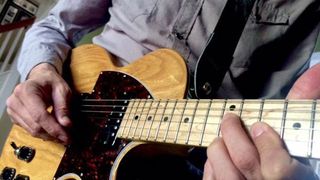One of the first progressions many guitarists tackle when learning to improvise in the jazz idiom is the ii-V-I.
This common three-chord progression can be found in countless jazz tunes, and improvising over these chords in a convincing fashion is a must-know skill for any budding jazz guitarist to have under their fingers.
When beginning to explore these important chords in the practice room, many of us work out the major key ii-V-I’s and think to ourselves, “Well, that wasn’t too bad” But when we jump over and start checking out minor key ii-V-i progressions, it can be a totally different story.
Whereas you can technically use one scale over all three chords in a major key ii-V-I, at least when starting out, that same approach falls flat when tackling minor key ii-V-i’s. Because of this, you’ll need to use three different scales, one for each chord, to properly outline each change in the progression.
In this lesson, we’ll take a look at how to use three different scales to improvise over minor key ii-V-i’s while still keeping everything related to the tonic key. This will allow you to sound each chord in the progression, while keeping things connected in a meaningful way to the tonic chord in that particular key.
Tonic Natural Minor: iim7b5
The first chord in the progression is the iim7b5 chord, Dm7b5 in the key of C minor as in the example below.
For this chord, we’re going to improvise using the C Natural Minor (Aeolian) Scale. I’ve written out this scale starting on the note D, so that you can see how it relates to the chord in question. This produces a D Locrian Mode for those of you who prefer to think about modes in that fashion.
Try soloing with a C Natural Minor Scale over a Dm7b5 backing track to get a feel for how this scale sounds over the iim7b5 chord.

Tonic Harmonic Minor: V7alt
For the second chord in the progression, V7alt or G7b9b13 in this key, we will apply the tonic Harmonic Minor Scale. This means that over a G7alt chord you will solo using the C Harmonic Minor Scale. When applied to a V7 chord, this scale produces both b9 and b13 intervals which take care of the “alt” part of the chord, and give you plenty of tension to play with over this change before resolving to the next chord in the progression.
This approach, the 5th mode of Harmonic Minor over a dominant 7 chord, is a great sounding and widely used approach to soloing over these chords in a jazz context. Being able to apply this mode to a V7 chord will not only help you within the context of a ii-V-i progression, but it will allow you to spice up any 7th chord that you find in different tunes and vamps.

Tonic Melodic Minor: im6
To navigate the last chord in the progression, im6 or Cm6 in this key, you will delve into the tonic Melodic Minor Scale in your solos. This scale produces both a M6 and M7 intervals, giving it a very strong and tense sound over minor chords, as compared to the more mellow Dorian or Aeolian modes that you may have already been using with this chord.

Tonic Scales for Minor ii-V-i
Check out the example below to see how all three tonic minor scales fit over a ii-V-i progression in the key of C minor.
In this example, I’ve started each scale on the tonic, C, for an easy and quick comparison. In order to apply this concept to your playing, you’ll need to have these three different scales under your fingers in different parts of the neck.
So, if any of these three scales is new to you, or you don’t feel you have a strong command of them on the guitar, take the time to really get these scales down on the fretboard. It will not only help you navigate this progression, but many others in the jazz idiom as well.

Three Minor iim7b5-V7alt-im6 Licks
To finish up, I’ve written out three of my favorite minor ii-V-i licks that use the 3 minor scale approach over each chord.
Learn these licks and take them to different keys across the neck. Try improvising with them and altering them as you go, adding notes, taking notes away, changing the rhythm etc.
Then, once you have these licks under your fingers, write out some of your own. Or, if you feel comfortable, transcribe a few minor ii-V-i licks by your favorite players to see how they use this approach in their playing.

Practice Tips
Here are five ways you can take these ideas into the woodshed and explore them further in the practice room.
- Improvise over each chord separately using a backing track in all 12 keys. Stick to the corresponding scale for that chord, i.e. Natural Minor for the m7b5 chord in any key.
- Combine the iim7b5 and V7alt chords and improvise over them in 12 keys.
- Combine the V7alt and the im6 chords and improvise over them in all 12 keys
- Put all three chords together and improvise over ii-V-i’s in all 12 keys.
- Do the above four exercises using a variety of tempos, from a 50 bpm to 250 and beyond.
Matt Warnock is the owner of mattwarnockguitar.com, a free website that provides hundreds of lessons and resources designed to help guitarists of all experience levels meet their practice and performance goals. Matt lives in the UK, where he is a senior lecturer at the Leeds College of Music and an examiner for the London College of Music (Registry of Guitar Tutors).


